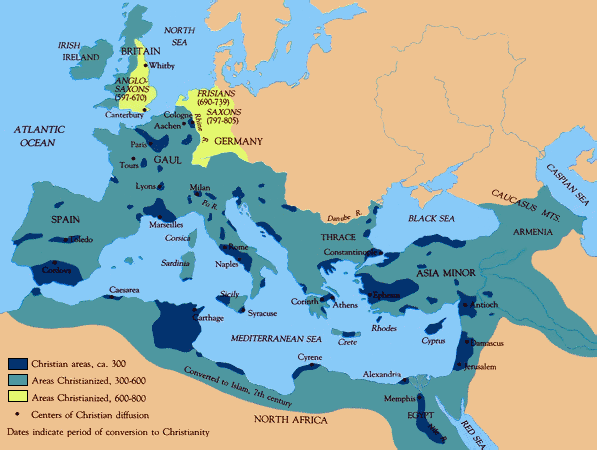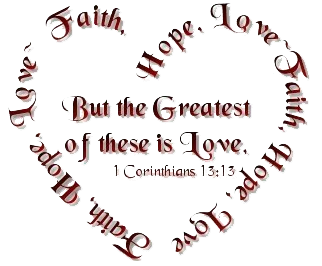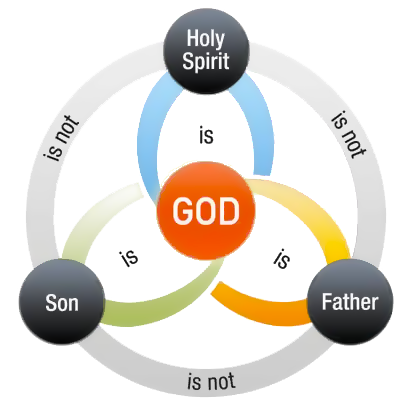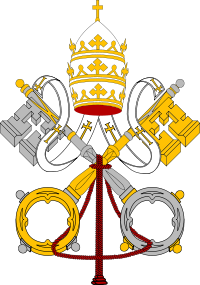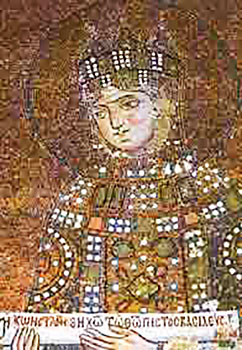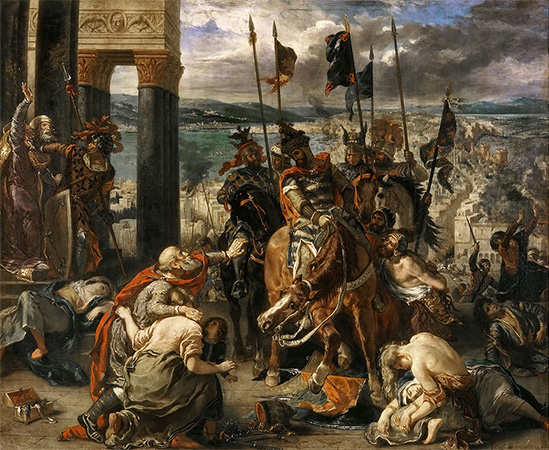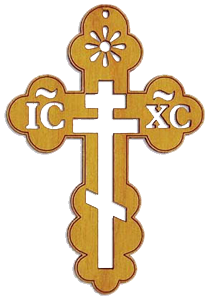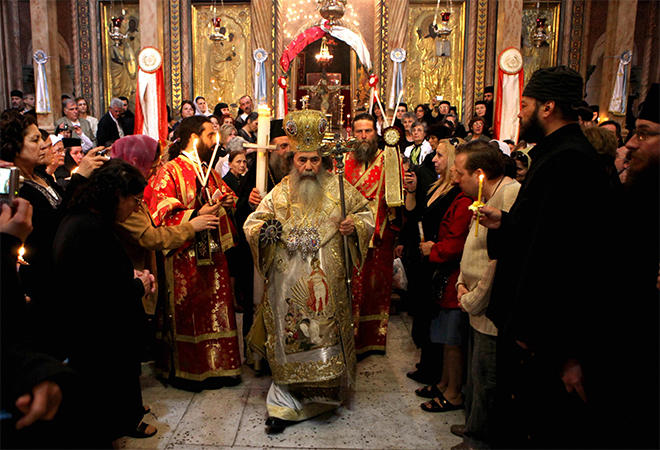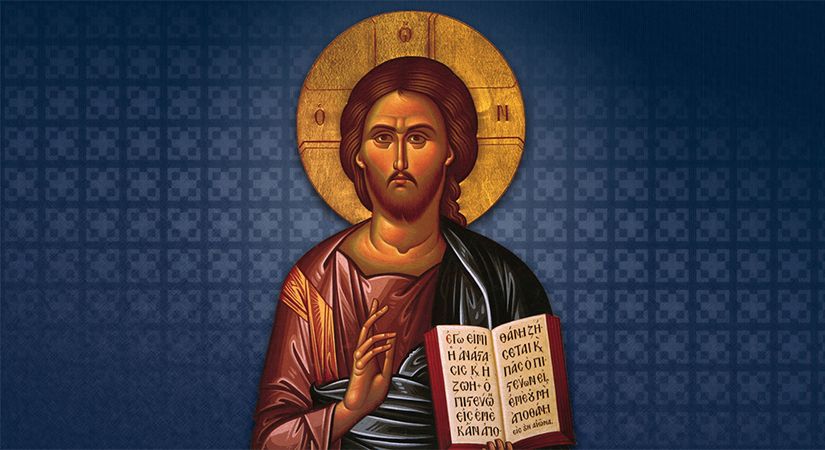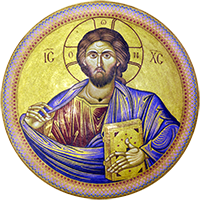
Reflecting
on the life of Jesus and their experience of the risen Christ,
Christians believed that the transcendent and invisible God had become
immanent and visible in Jesus. This led to the early development
of the doctrine of the Holy Trinity, which speaks of three equal “persons”
within one divine being: Father, Son, and Holy Spirit. The Father is
the one who sends the Son to become incarnate in Jesus with the mission
to reveal God’s love to the world. The Son or Word manifests God
in the world in many ways, but the incarnation in Jesus is a
culmination of that revelation. The Holy Spirit, or Holy Ghost,
who Jesus promises will be sent after his death, is the power and
presence
of God, actively guiding and sustaining the faithful.
Although
Jesus had spoken in parables, the
evolving Church found it necessary to articulate some of its beliefs
more openly and systematically. A number of creeds,
or professions of faith, were composed for use in religious instruction
and baptism, to define who Jesus was and his relationship to God, and
to provide clear stands in the face of various controversies. One major
controversy concerned the teachings of Arius,
a leader of the congregation in Alexandria. The issue was the
relationship between God and Jesus. The Christians worshipped Jesus,
but at the same time came from monotheistic Jewish tradition, in which
God alone is worshiped. Was Jesus therefore somehow the same as God?
To Arius, God the Father pre-existed God the Son, whereas opponents of
this belief insisted that the Son of God was equally eternal with God
the Father.
Constantine convened a general council of the bishops
of all area churches in Nicea in 325 CE to settle this critical issue. Arius’s beliefs were rejected
at the Council of Nicaea and again at the Council of Constantinople in 381 CE. The Nicene Creed,
as it is known today, is a compilation of the statements of faith from
both of these councils. It is still the basic profession of
faith for many Christian
denominations and has been proposed as a basis for unifying all Christians:
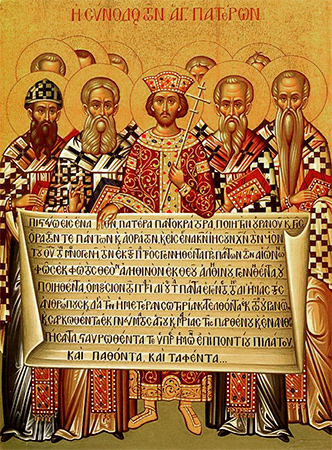 We
believe in
one God, the Father, the almighty,
maker of heaven and earth, of all that is, seen and unseen. We believe
in one Lord, Jesus Christ, the only Son of God, eternally begotten of
the Father, God from God, Light from Light, true God from true God,
begotten not made, of one Being with the Father. Through him all things
were made. For us men and for our salvation he came down from heaven;
by the power of the Holy Spirit he became incarnate of the Virgin Mary,
and was made man. For our sake he was crucified under Pontius Pilate;
he suffered death and was buried. On the third day he rose again in
accordance with the Scriptures; he ascended into heaven and is seated
at the right hand of the Father. He will come again in glory to judge
the living and the dead, and his kingdom will have no end. We believe
in the Holy Spirit, the Lord, the giver of life, who proceeds from the
Father [and from the Son]. With the Father and the Son he is worshipped
and glorified. He has spoken through the Prophets. We believe in one
holy, catholic, and apostolic Church. We acknowledge one baptism for
the forgiveness of sins. We look for resurrection of the dead, and the
life of the world to come. Amen. (Living Religions,
325; note that the words “and from the Son” in square brackets were
added by the Western Church in the early Middle Ages, as discussed
further below) We
believe in
one God, the Father, the almighty,
maker of heaven and earth, of all that is, seen and unseen. We believe
in one Lord, Jesus Christ, the only Son of God, eternally begotten of
the Father, God from God, Light from Light, true God from true God,
begotten not made, of one Being with the Father. Through him all things
were made. For us men and for our salvation he came down from heaven;
by the power of the Holy Spirit he became incarnate of the Virgin Mary,
and was made man. For our sake he was crucified under Pontius Pilate;
he suffered death and was buried. On the third day he rose again in
accordance with the Scriptures; he ascended into heaven and is seated
at the right hand of the Father. He will come again in glory to judge
the living and the dead, and his kingdom will have no end. We believe
in the Holy Spirit, the Lord, the giver of life, who proceeds from the
Father [and from the Son]. With the Father and the Son he is worshipped
and glorified. He has spoken through the Prophets. We believe in one
holy, catholic, and apostolic Church. We acknowledge one baptism for
the forgiveness of sins. We look for resurrection of the dead, and the
life of the world to come. Amen. (Living Religions,
325; note that the words “and from the Son” in square brackets were
added by the Western Church in the early Middle Ages, as discussed
further below)
|
|
How did the decision to emphasize "dogma"
shape the development of Christianity?
How might Christianity be different today had Arius been allowed to maintain
a different interpretation of the relationship between God and Jesus?


|
The First Schism
The Eastern Orthodox Church
Politically, late
in the third century CE, the Roman Empire had been divided into two: an
eastern section and a western section. ... While religious power in the west became more and more centralized in the Roman pope [i.e.
the bishop of Rome], the eastern sees had no equivalent centralization, nor did they recognize the Roman pope’s claim to universal authority over the Church. ... By the early Middle
Ages, there were also doctrinal disagreements. In its version of
the Niceno-Constantinopolitan Creed, for example, the Western Church
added the filioque, a formula professing that the Holy Spirit
came from the Father “and from the Son”; the Eastern Church
retained what is considered the more original text, professing that the
Holy Spirit proceeds only from the Father.
In 1054, leaders of the
eastern and western
factions excommunicated each other over the disagreement about the Holy
Spirit, the papal claim, and whether the Eucharistic bread should be leavened or
unleavened. To the Eastern Church, the last straw was its
treatment by crusaders. (Living Religions, 327-8)
Is religious fragmentation an inevitable consequence of religious growth?
Is such fragmentation positive, negative, or neutral?
Over the centuries, the individual Orthodox Churches have
probably changed less than have the many descendants of the early
Western Church. There is a strong conservative tradition, attempting to
preserve the pattern of early Christianity. Even though the religious
leaders can make local adaptations suited to their region and people,
they are united in doctrine and sacramental observances. Any change
that will affect all churches is decided by a synod — a council of officials trying to reach common agreements, as did the early Church. ...
A central practice is called “unceasing prayer”: the
continual remembrance of Jesus or God, often through repetition of a
verbal formula that gradually impresses itself on the heart. The most
common petition is the “Jesus prayer”: “Lord Jesus Christ, Son of God,
have mercy on me, a sinner.” The repetition of the name of Jesus brings
purification of heart and singularity of desire. To call upon Jesus is
to experience his presence in oneself and in all things.
The Orthodox Church has affirmed that
humans can
approach God directly through faith, as opposed to intellectual knowledge. ... Some may even see the light of God and be
utterly
transformed by it:
| He who participates in the divine energy,
himself becomes, to some extent, light: he is united to the
light, and by that light he sees in full awareness all that remains
hidden to those who have not this grace; … for the pure in heart see
God … who, being Light, dwells in them and reveals Himself to those who
love Him, to His beloved. |
Another distinctive feature of Orthodox Christianity is its veneration of icons.
These are stylized paintings of Jesus, his mother Mary, and the saints.
They are created by artists who prepare for their work by prayer and
ascetical training. There is no attempt at earthly realism, for icons
are representations of the reality of the divine world. They are
beloved as windows to the eternal. In addition to their devotional and
instructional functions, some icons are reported to have great
spiritual powers, to heal illnesses, and to transmit the holy presence.
Believers enter into the grace of this power by kissing the icon
reverently and praying before it. (Living Religions, 341-3)
|

|

